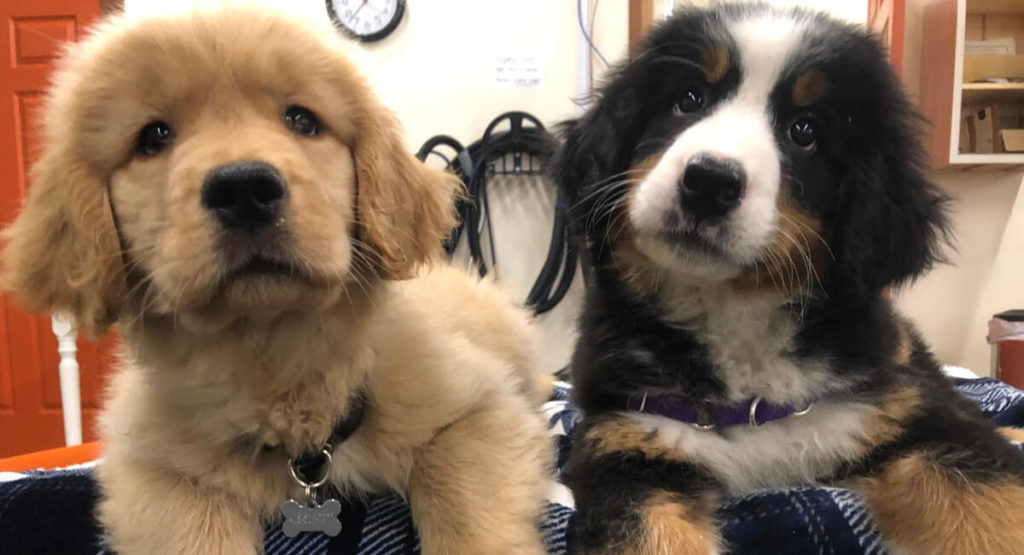
The use of punishment with a puppy has diminished sharply among professional trainers. And yet there are still some who use it. I must admit, this mystifies me.
Without delving too deeply, the definition of punishment includes the use of something aversive, like force, coercion, or physical correction to change an animal’s behavior. Methods used over the years have ranged from a rolled newspaper, a can of coins, to a pronged collar, choke chain, or ecollar, all of which can startle, physically jerk, shock, bruise, mystify and frighten a puppy.
Before we go on, it may be useful to look at what we’ve discovered about punishment and why it is contraindicated. One great resource is the American Veterinarian Society of Animal Behaviorists (AVSAB) which has published several very good position statements, especially this one on Punishment.
Over the years I have found that using punishment with puppies has no effect on unwanted puppy behaviors but rather may trigger some unforeseen and unfortunate results. Training alternate behaviors on the other hand changes worlds.
Perils and Pitfalls of Punishment
When it comes to puppies, it is important to remember we are dealing with a baby mind that is distractible, impetuous, lacks impulse control, has no social skills, and a strong sense of play. None of these things warrant discipline, no matter what behavior they are fueling at the moment.
I would urge anyone considering the use of punishment with their puppy to make sure they get a resounding, “Yes!” to all of the following questions so they can make the best decision;
-
- Your puppy will understand he is being punished, but he can still trust you and know you will protect him,
- He will know exactly what he’s being punished for,
- There will be zero, nada, zilch lingering fear or ill effect on your relationship, and,
- Your puppy will never. Ever. Do that behavior again.
- Raising a puppy is equal parts frustrating, exhausting, even exasperating. People confide a range of feelings, from deep emotion to fear they are failing their puppy because they don’t know what to do about unwanted behaviors. Puppies for their part are, well, puppies. Still it is important to know what we stand to lose should we opt to punish.
Regardless of the behaviors that need changing or the training that you need help with, chances are you need a break, and if this is the case, your puppy probably needs a break, too.
Start with a Time Out
Puppies, like toddlers get wound up when they have too much energy, or too little. This is when they resort to the old standbys; biting, barking, jumping, chewing, pulling away… Since none of these behaviors is a prelude to learning something more constructive, it’s frequently a good idea to take a time out.
Time out – The Great Calm Down
No matter what is happening I don’t suggest you pluck a puppy out of an overcharged moment and try to teach him an alternate behavior. Better to stop, take a break, and lower everyone’s heartrate. None of us learn well when we are overstimulated or tired.
Using a time out keeps everything neutral and is therefore superior to physical restraint which will only make things worse by adding fuel to the fire (“fuel,” meaning resistance, anger, even fear).
Worst of all, restraint without training simply gives a puppy something tangible to resist – you. You’ll want to avoid any state of resistance as you educate, be it a toddler, giraffe, horse, whale, or puppy. Resistance takes learning out of the equation. It is it’s own lesson and can only be counterproductive.
Time Out ≠ Punishment
A brief time out is not punishment, but rather quiet time to regroup and calm down. Time outs are especially helpful with large breed puppies as no one can force an 50-80 lb dog to calm down, no matter how much force you exert. He must accomplish this on his own—on request.
You can do a time out by simply putting your puppy in his pen with a bully stick and letting him cool off for a few minutes. You don’t need to leave the room. Just chill for a moment. Once he’s settled, let him out. If he falls asleep, let him sleep as long as he needs to. Then go for a potty break, take a short walk, and relax. This is tantamount to walking away from a volatile situation and starting again later (or tomorrow). These periods of intense or explosive blow-outs will diminish in time as your puppy develops more impulse control and maturity.



